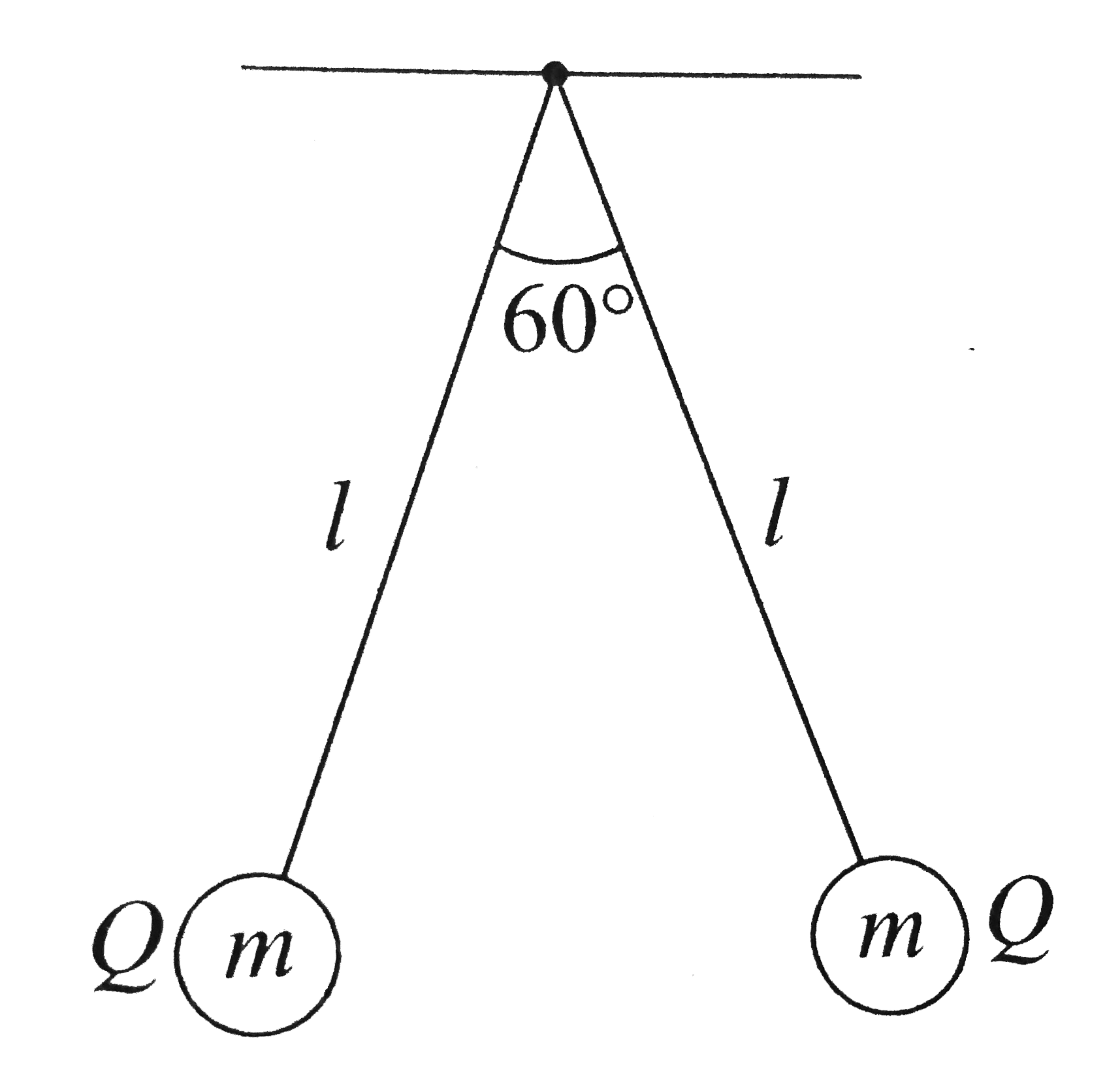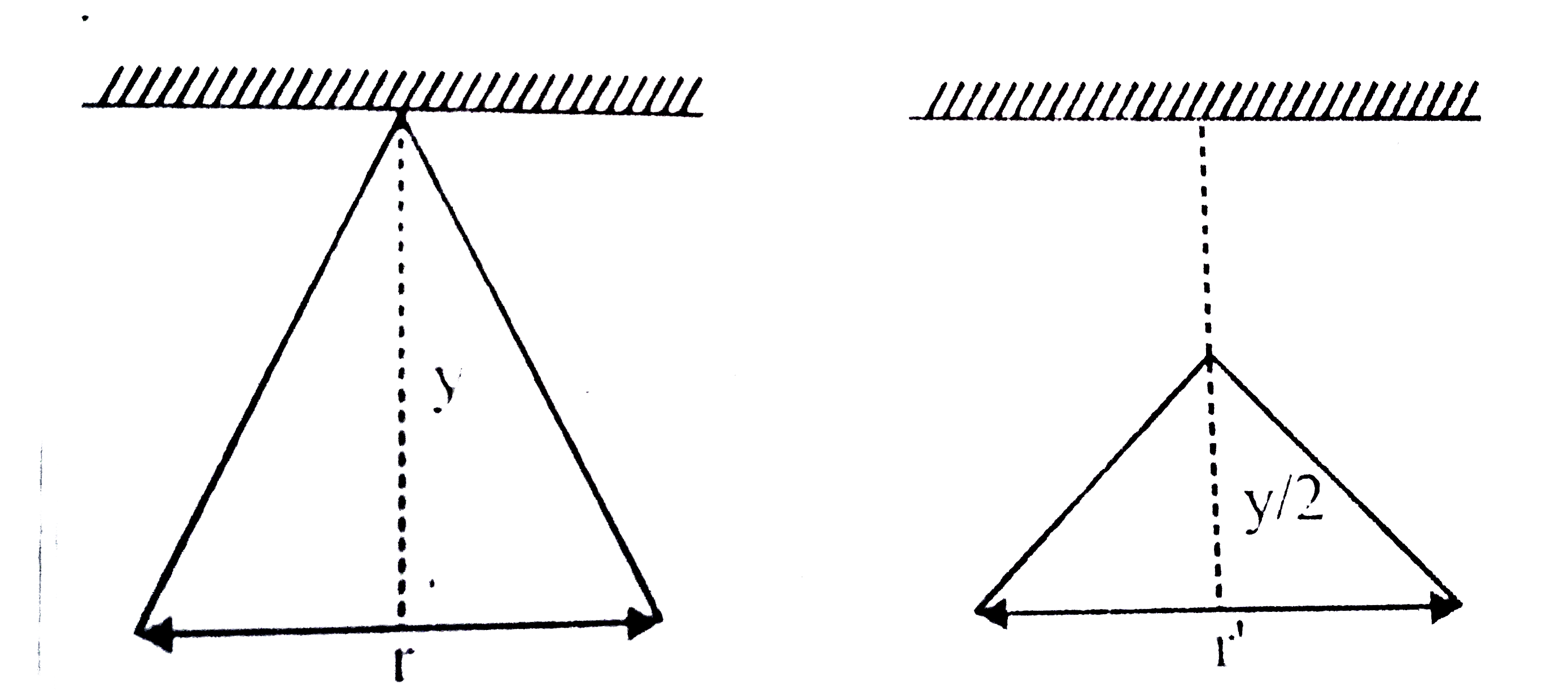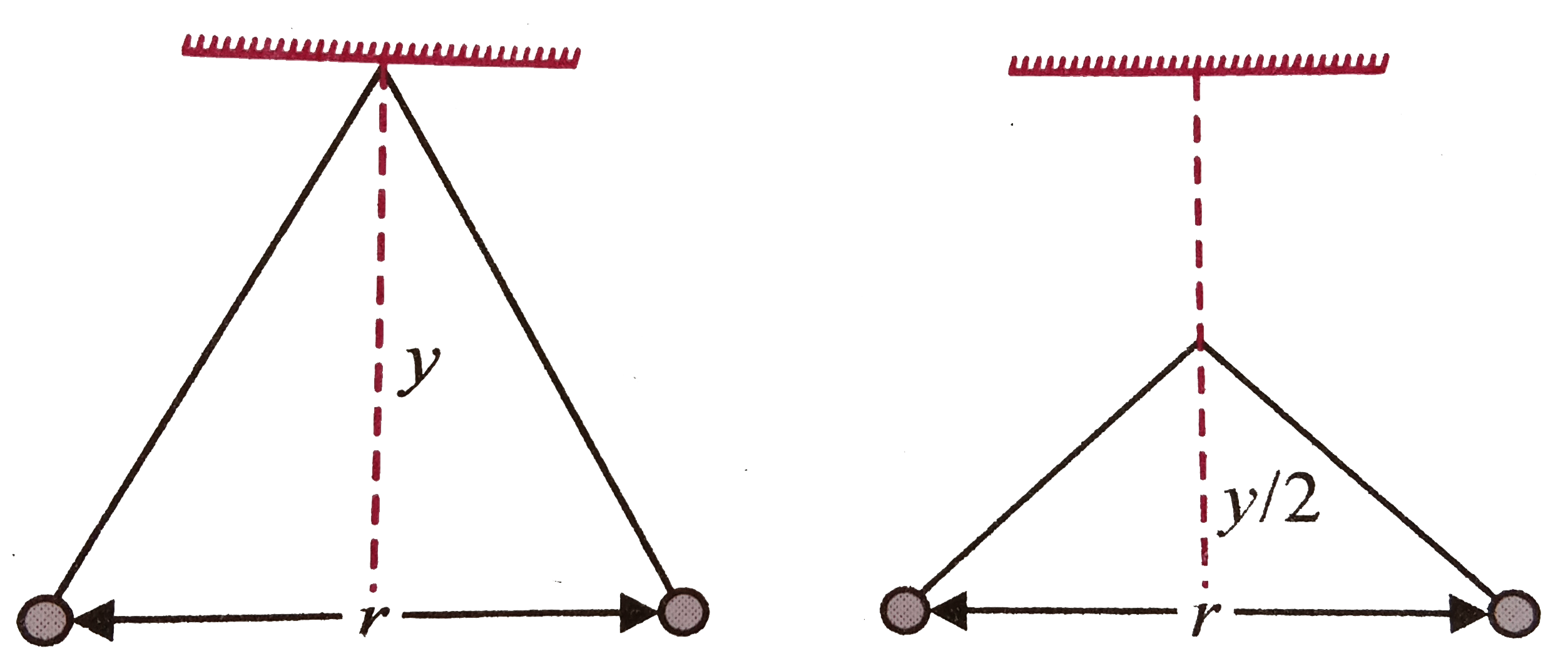Two indentical pith balls, each carrying charge q, are suspended from a common point by two strings of equal length l. Find the mass of each ball if the angle between the strings is 2θ in equilibrium.
To solve the problem, we will follow these steps:
Step 1: Understand the setup
We have two identical pith balls, each carrying a charge q, suspended from a common point by two strings of equal length l. The angle between the strings is 2θ.
Step 2: Analyze the forces acting on the balls
Each ball experiences two main forces:
1. The gravitational force acting downwards, which is mg, where m is the mass of each ball.
2. The electric force due to the repulsion between the two charged balls.
Step 3: Determine the components of the forces
Since the balls are in equilibrium, we can analyze the forces along the direction of the strings and perpendicular to the strings.
- The component of the gravitational force along the string is:
mgcosθ
- The component of the gravitational force perpendicular to the string is:
mgsinθ
For the electric force Fe between the two balls, which acts horizontally, we can also resolve it:
- The component of the electric force along the string is:
Fesinθ
- The component of the electric force perpendicular to the string is:
Fecosθ
Step 4: Set up the equilibrium conditions
In equilibrium, the forces perpendicular to the string must balance. Therefore, we have:
mgsinθ=Fecosθ
Step 5: Express the electric force
The electric force Fe between two point charges is given by Coulomb's law:
Fe=kq2x2
where k is Coulomb's constant and x is the distance between the two balls.
Step 6: Relate x to l and θ
Using geometry, the distance x between the two balls can be expressed as:
x=2lsinθ
Step 7: Substitute Fe into the equilibrium equation
Substituting Fe into the equilibrium condition gives:
mgsinθ=(kq2(2lsinθ)2)cosθ
Step 8: Simplify the equation
Rearranging the equation, we get:
mgsinθ=kq2cosθ4l2sin2θ
Multiplying both sides by 4l2sin2θ:
4mgl2sin3θ=kq2cosθ
Step 9: Solve for the mass m
Now, we can isolate m:
m=kq2cosθ4gl2sin3θ
Final Answer
Thus, the mass of each ball is given by:
m=kq2cosθ4gl2sin3θ
---
We have two identical pith balls, each carrying a charge q, suspended from a common point by two strings of equal length l. The angle between the strings is 2θ.
Each ball experiences two main forces:
1. The gravitational force acting downwards, which is mg, where m is the mass of each ball.
2. The electric force due to the repulsion between the two charged balls.
Since the balls are in equilibrium, we can analyze the forces along the direction of the strings and perpendicular to the strings.
mgcosθ
- The component of the gravitational force perpendicular to the string is:
mgsinθ
- The component of the electric force along the string is:
Fesinθ
- The component of the electric force perpendicular to the string is:
Fecosθ
In equilibrium, the forces perpendicular to the string must balance. Therefore, we have:
mgsinθ=Fecosθ
The electric force Fe between two point charges is given by Coulomb's law:
Fe=kq2x2
where k is Coulomb's constant and x is the distance between the two balls.
Using geometry, the distance x between the two balls can be expressed as:
x=2lsinθ
Substituting Fe into the equilibrium condition gives:
mgsinθ=(kq2(2lsinθ)2)cosθ
Rearranging the equation, we get:
mgsinθ=kq2cosθ4l2sin2θ
Multiplying both sides by 4l2sin2θ:
4mgl2sin3θ=kq2cosθ
Now, we can isolate m:
m=kq2cosθ4gl2sin3θ
Thus, the mass of each ball is given by:
m=kq2cosθ4gl2sin3θ
Topper's Solved these Questions
- ELECTROSTATICSBOOK - DC PANDEY ENGLISHCHAPTER - ELECTROSTATICSEXERCISE - Example Type 5
5 Videos
- ELECTROSTATICSBOOK - DC PANDEY ENGLISHCHAPTER - ELECTROSTATICSEXERCISE - Example Type 6
4 Videos
- ELECTROSTATIC POTENTIAL AND CAPACITORSBOOK - DC PANDEY ENGLISHCHAPTER - ELECTROSTATIC POTENTIAL AND CAPACITORSEXERCISE - (C) Chapter exercises
50 Videos
- GRAVITATIONBOOK - DC PANDEY ENGLISHCHAPTER - GRAVITATIONEXERCISE - All Questions
135 Videos
Similar Questions
Two identical pith balls, each carrying charge q, are suspended from a common point by two strings of equal length l. Find the mass of each ball if the angle between the strings is 2θ in equilibrium.
View SolutionTwo identical balls each having a density ρ are suspended from as common point by two insulating strings of equal length. Both the balls have equal mass and charge. In equilibrium each string makes an angle θ with vertical. Now, both the balls are immersed in a liquid. As a result the angle θ does not change. The density of the liquid is σ. Find the dielectric constant of the liquid.
View SolutionTwo identical balls each having a density ρ are suspended from as common point by two insulating strings of equal length. Both the balls have equal mass and charge. In equilibrium each string makes an angle θ with vertical. Now, both the balls are immersed in a liquid. As a result the angle θ does not change. The density of the liquid is σ. Find the dielectric constant of the liquid.
View SolutionAssertion : Two identical balls are charged by q. They are suspended from a common point by two insulating threads l each. In equilibrium, the angle between the tension in the threads is 180∘. (Ignore gravity).
Reason : In equilibrium tension in the spring is
T=14πε0q.ql2
View SolutionTwo small balls, each having equal positive charge Q are suspended by two insulationg strings of equal length l from a hook fixed to a stand. It mass of each ball =m and total angle between the two strings is 60∘m, then find the charge on each ball.

View SolutionTwo pitch balls carrying equal charges are suspended from a common point by strings of equal length, the equilibrium separation between them is r. Now the strings are rigidly clamped at half the height. The equilibrium separation between the balls now become

View SolutionTwo identical balls , each having a charge q and mass m , are suspended from a common point by two insultating strings each of length L. The balls are held at a separation x and then released. Find
(a) the electric force on each ball
(b) the component of the resultant force on a ball along and perpendicular to string
(c ) the tension in the string
(d) the acceleration of one of the balls. Consider the situation only for the instant just after the release.
View SolutionTwo path balls carrying equal charges are suspended from a common point by strings of equal length, the strings are rightly clamped at half the height. The equilibrium separation between the balls, now becomes :

View SolutionTwo identical pith balls are charged by rubbing against each other. They are suspended from a horizontal rod through two strings of length 20 cm each, the separation between the suspension points being 5 cm. in equilibrium, the separation between the balls in 3 cm. Find the mass of each ball and the tension in the strings. the charge on each ball of a magnitude 2.0×10−8C.
View SolutionTwo small spheres, each having a mass of 20 g, are suspended form a common point by two insulating strings of length 40 cm each. The spheres are identically charged and the speration between the balls at equilibrium is found to be 4 cm . Find the charge on each sphere.
View Solution
